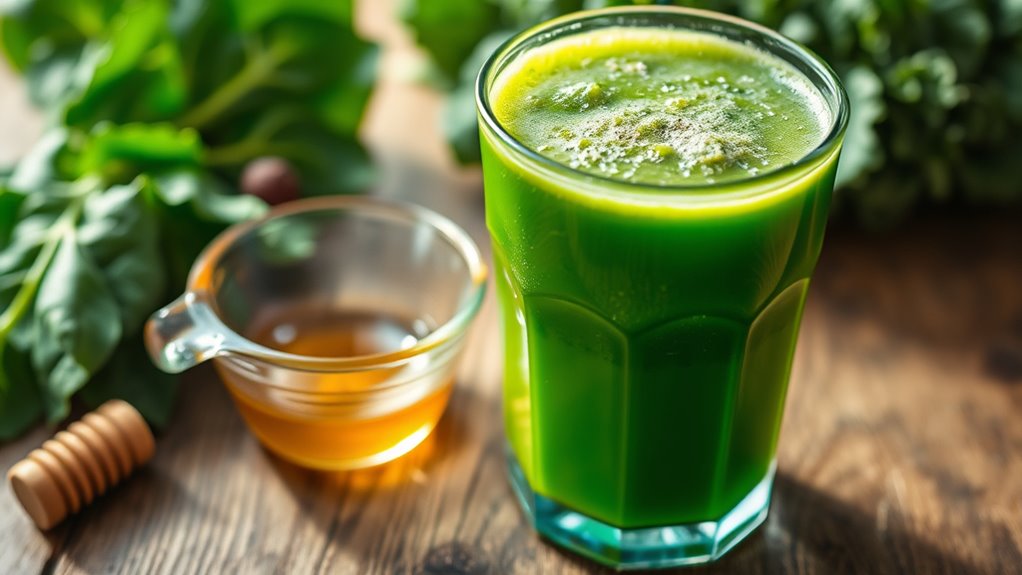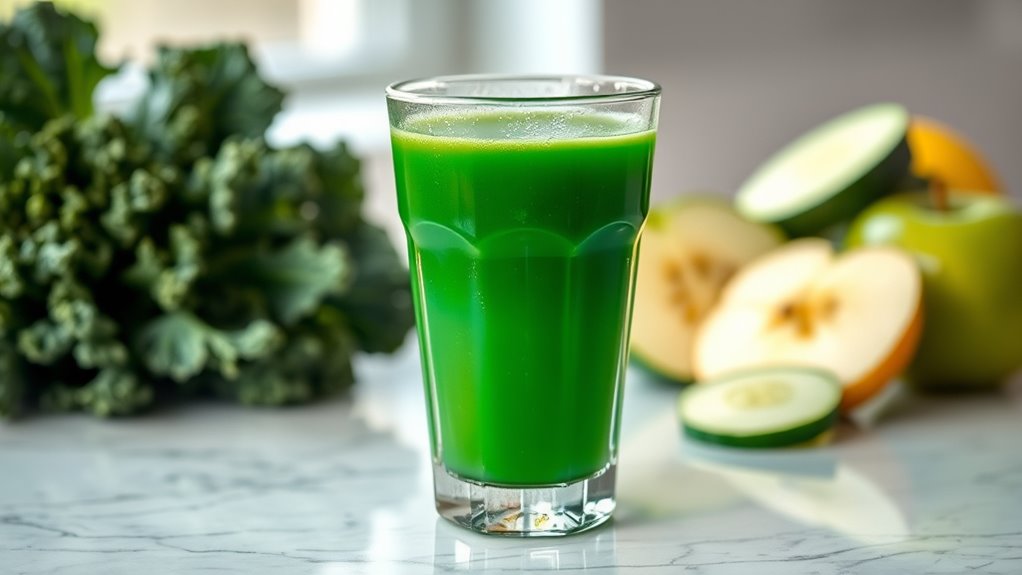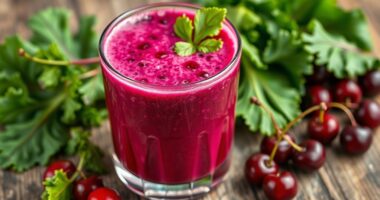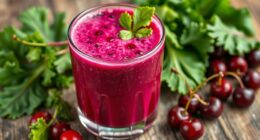When choosing green juices, check labels carefully for hidden sugars like honey, agave syrup, or fruit juice concentrates, which can be listed under ingredients or shown as added sugars. Over 5 grams of sugar per serving is a red flag. Be cautious of “all-natural” claims—some contain hidden sweeteners. To spot these traps quickly, focus on minimal ingredients, especially vegetables. Keep going for tips that help you pick healthier options effortlessly.
Key Takeaways
- Check ingredients for honey, agave, or fruit juice concentrates, which indicate added sugars.
- Review the nutrition label; over 5 grams of sugar per serving suggests hidden sugars.
- Recognize that “all-natural” labels can still contain hidden or added sugars.
- Prefer juices with minimal ingredients, ideally just vegetables or small amounts of fruit.
- Making green juice at home allows full control to avoid added or hidden sugars.

Have you ever wondered if your green juice is truly healthy? Sometimes, what seems like a nutritious choice can hide a lot of sugar behind the scenes. Many commercial green juices contain added sugars or natural sweeteners that you might not realize just by glancing at the label. That’s why label reading becomes an essential skill when you want to avoid consuming hidden sugars. It’s easy to assume that a green juice labeled “healthy” or “all-natural” is free of unnecessary additives, but that’s often not the case. Manufacturer’s labels can be tricky, hiding ingredients that sound harmless but are packed with sugar.
When you check the ingredients list, look for terms like honey, agave syrup, or fruit juice concentrates. These are common natural sweeteners that can *considerably* increase the sugar content of your juice. While they might seem better than refined sugar, they still contribute to your overall sugar intake. The trick is to find juices that have minimal ingredients—preferably just green vegetables and a small amount of fresh fruit. Many brands add fruit juices or natural sweeteners to enhance flavor, which can make the juice taste better but also adds unnecessary sugar.
To spot hidden sugars in seconds, focus on the nutrition label. Look at the grams of sugar per serving—if it’s over 5 grams, think twice. Remember, natural sugars from whole fruits or vegetables are different from added sugars, but the label doesn’t always distinguish between the two. That’s where label reading becomes invaluable. Some brands list “added sugars” separately, making it easier to identify how much extra sugar has been added beyond the natural content. If you see ingredients like cane sugar, corn syrup, or fruit juice concentrates, know these are sources of hidden sugars. Additionally, understanding the impact of sleep on mental health can help you establish habits that support your overall well-being, including making healthier dietary choices.
Choosing green juices with natural sweeteners is possible, but it requires vigilance. Opt for brands that list only vegetables and a small amount of fruit or those that use minimal or no added sweeteners. Making your own green juice at home allows you full control over what goes in. You can sweeten it naturally with a squeeze of lemon or a small piece of apple, avoiding processed or hidden sugars altogether.
In the end, being a savvy label reader empowers you to make better choices and truly enjoy a healthy green juice without the hidden sugars. It’s about paying attention to what’s on the label, understanding the ingredients, and knowing that “all-natural” doesn’t always mean sugar-free. Your health depends on it, so take a moment to read that label carefully before you sip.
Frequently Asked Questions
Are Organic Green Juices Less Likely to Contain Hidden Sugars?
Organic green juices are less likely to contain hidden sugars because organic farming avoids added sugars and focuses on natural ingredients. Plus, organic produce tends to have lower pesticide residues, which might influence the juice’s purity. However, always check labels because some brands add sweeteners even if they’re organic. You’re better off choosing juices labeled as 100% organic and scrutinizing ingredient lists for any added sugars to stay safe.
Can Green Juice Recipes Be Modified to Reduce Sugar Content?
You can definitely modify green juice recipes to reduce sugar content. Try fruit substitutions with lower-sugar options like berries or green apples. Additionally, add fiber enhancements such as chia seeds or flaxseeds to make the juice more filling without extra sugar. This way, you enjoy a healthier drink that still tastes great, while cutting back on the hidden sugars often found in traditional recipes.
Do All Store-Bought Green Juices Contain Added Sugars?
Think of store-bought green juices as a tempting candy shop—some hide secrets behind artificial sweeteners and flavor masking that you might not see. Not all contain added sugars, but many do, often disguised to enhance taste. Always read the label carefully, looking beyond the front to spot sneaky ingredients. By staying vigilant, you can avoid those hidden sugars and enjoy your green juice as genuinely healthy fuel.
How Do Natural Sugars in Green Juices Affect Blood Sugar Levels?
Natural sugars in green juices can impact your blood sugar levels by causing a quick rise, which triggers your insulin response. This effect varies depending on how much sugar you consume and your body’s sensitivity. While natural sugars are generally better than added sugars, they still influence blood sugar. To maintain steady energy, watch your intake and opt for juices with lower fruit content or add protein to slow absorption.
Are There Specific Green Vegetables That Naturally Lower Sugar Content?
You’re wondering if certain green vegetables naturally lower sugar content. Leafy greens like spinach and kale, along with cruciferous vegetables such as broccoli and Brussels sprouts, are low in sugar and rich in fiber. They help stabilize blood sugar levels naturally. Incorporate these into your juices or meals to enjoy their health benefits while keeping sugar intake in check. These vegetables support balanced blood sugar without added sugars.
Conclusion
By now, you can spot hidden sugars in green juices like a detective on a trail. Remember, even the “healthy” ones can hide sweet tricks behind their vibrant facade. Always read labels and trust your instincts—don’t let sneaky sugars steal your wellness. Think of these hidden sugars as wolves in sheep’s clothing; once you’re aware, you hold the power to protect your health and make smarter choices with every sip.










